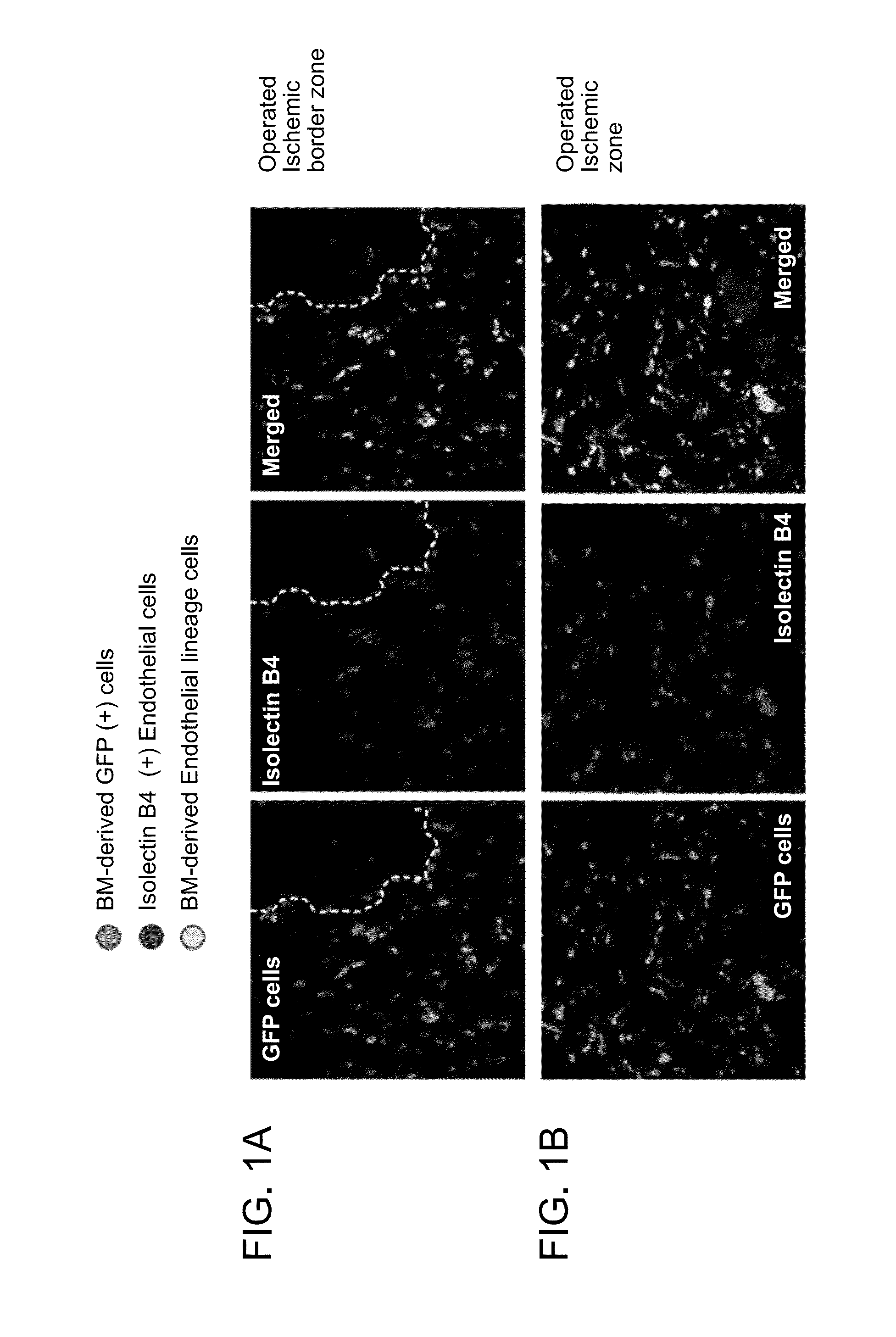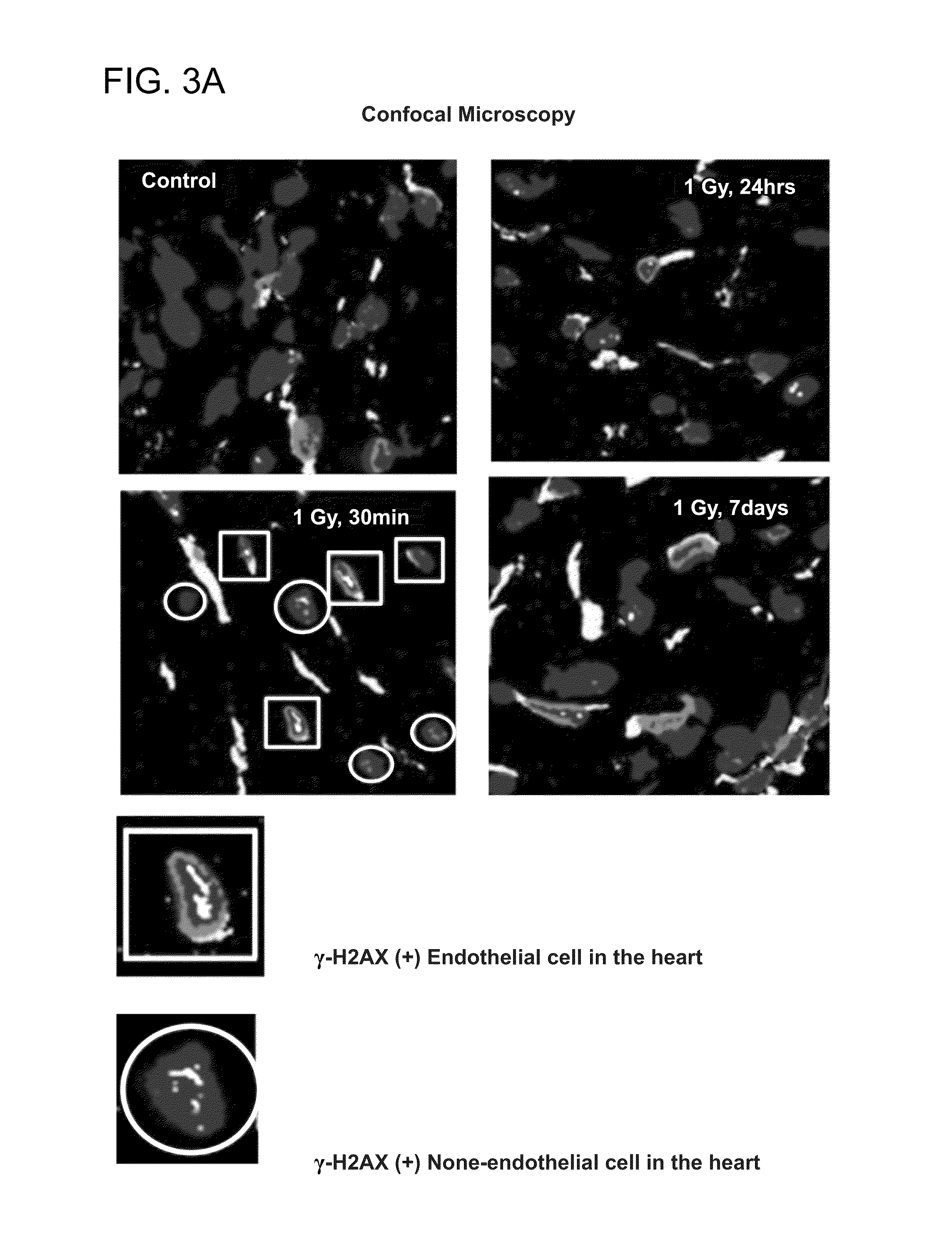Compositions and methods for the treatment of radiation exposure
- Summary
- Abstract
- Description
- Claims
- Application Information
AI Technical Summary
Benefits of technology
Problems solved by technology
Method used
Image
Examples
example 1
DNA DSB Repair in BM-Derived EPCs is Inefficient or Delayed after Exposure to γ-Radiation
[0282]A chimeric animal model derived from green fluorescent protein (GFP) bone marrow (BM) transplanted into C57Bl6J mice11 was used to study the effects of radiation exposure. In ischemic tissue [hindlimb ischemia (HLI) induced by surgical ligation and removal of the femoral artery] at 28 days post-surgery, 60-70% of ECs in the ischemic tissue were BM-derived EPCs (FIGS. 1A and 1B). These data indicated that BM-derived EPCs are recruited to the sites of ischemic injury in large numbers and that BM-derived EPCs substantially contribute to post-natal neovascularization.
[0283]To assess the effect of low-dose radiation in BM-derived EPC, exposure to a full body single dose 1 Gy γ-irradiation (low linear energy transfer (LET) type of radiation) on the formation of γ-H2AX foci was evaluated in BM-derived EPCs in C57 / Bl6J mice. BM-derived EPCs were isolated 30 min, 24 hours and 7 days post-irradiatio...
example 2
DNA DSB Repair in BM-Derived EPCs is Inefficient or Delayed after Exposure to γ-Radiation
[0289]To assess the effect of low-dose radiation on BM-derived EPCs the effect of a full-body single dose (0.15 Gy, 1 Gev / n) Iron irradiation on the survival and proliferation of BM-derived EPCs over 28 days post-irradiation was evaluated. BM-derived EPCs were isolated and maintained in corresponding selective EBM2 medium (supplemented with growth factors) ex-vivo for 48 and 72 hours (a minimum time required to select EPC from total BM ex-vivo in the culture). The results revealed that 2, 5, and 24 hrs after full-body irradiation, there was 2-6-fold increase in EPC apoptosis ex-vivo (FACS analysis, subGo / G1 fraction of the cells after PI staining), with peak 6-fold increased apoptosis at 5 hrs (p<0.001). EPC apoptosis was gradually decreased below control non-irradiated EPC levels by day 14. However, by day 28 there was a second significant 4-fold increase (p<0.03) in EPC apoptosis. The data ind...
example 3
Myocytes Exposed to γ-Radiation Sustained Increase in Cytoplasmic [Ca2+]i Concentration and Loss of Mitochondrial Membrane Potential
[0291]Studies demonstrated that exposure of myocytes to γ-radiation affected resting cytoplasmic [Ca2+] in myocytes. Preliminary results demonstrated that within 1 hr, γ-irradiation (1 Gy) of mice results in ˜28% (p2+]i. Compared to control, in N-IR myocytes resting intracellular Ca2+ levels remained 14% (p2+]i concentration is sustained for long periods of time (i.e., at least 7 days), leading eventually to mitochondrial calcium overload triggering activation of the permeability transition (PT) pore.
[0292]Studies demonstrated that exposure of myocytes to γ-radiation affected the mitochondrial membrane potential (Δ•m) in myocytes. A proper ΔΨm is essential for mitochondrial activity and is an indicator for the health of mitochondria. Within 1 hr following γ-irradiation (1 Gy) of mice, a substantial loss of ΔΨm in myocytes results. Furthermore, the loss ...
PUM
| Property | Measurement | Unit |
|---|---|---|
| Time | aaaaa | aaaaa |
| Time | aaaaa | aaaaa |
| Time | aaaaa | aaaaa |
Abstract
Description
Claims
Application Information
 Login to View More
Login to View More - R&D
- Intellectual Property
- Life Sciences
- Materials
- Tech Scout
- Unparalleled Data Quality
- Higher Quality Content
- 60% Fewer Hallucinations
Browse by: Latest US Patents, China's latest patents, Technical Efficacy Thesaurus, Application Domain, Technology Topic, Popular Technical Reports.
© 2025 PatSnap. All rights reserved.Legal|Privacy policy|Modern Slavery Act Transparency Statement|Sitemap|About US| Contact US: help@patsnap.com



